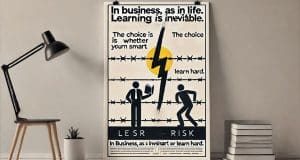
This quote is a humorous but sobering reminder that in business, as in life, our approach to learning can significantly impact our success, our teams, and our organisations. Let us dive deeper into the three types of learners and explore the consequences of each approach.
1. Learning by Reading: The Proactive Learner
Learning by reading represents those who actively seek knowledge, whether through books, articles, reports, or the experiences of others. These individuals are proactive -they anticipate challenges and arm themselves with information before problems arise. In the business world, this approach translates into thorough research, continuous professional development, and a commitment to staying ahead of the curve.
The Upside:
- Efficiency: These learners save time and resources by avoiding common pitfalls.
- Innovation: By learning from diverse sources, they often bring fresh ideas and approaches to their teams.
- Adaptability: They are usually well-prepared to navigate changing circumstances because they’ve already seen or read about various scenarios.
The Downside:
- Over-Reliance on Theory: Sometimes, learning by reading can lead to paralysis by analysis – too much information can prevent action.
- Lack of Practical Experience: Knowledge without application can lead to gaps when theory does not perfectly align with reality.
2. Learning by Observation: The Observant Learner
The second type of learner observes the actions and outcomes of others. They watch closely, absorbing lessons from the successes and failures around them. This form of learning is subtle. It requires attentiveness, critical thinking, and the ability to draw conclusions from indirect experiences.
The Upside:
- Less Risk Exposure: Observant learners avoid the direct consequences of mistakes while still gaining valuable insights.
- Strategic Insight: By watching others, these individuals often develop a strong sense of strategy, seeing what works and what does not in real time.
The Downside:
- Limited Control: Observation does not always provide the full context, leading to incomplete understandings.
- Passivity: Relying too heavily on observation without action can lead to missed opportunities.
3. Learning by Experience: The Hard Way
The third group learns the hard way – they have to “pee on the electric fence” to understand the consequences. These are the doers, the hands-on experimenters who dive headfirst into situations, learning through direct, often painful, experiences. While this approach can yield deep personal insights, it also comes with significant risks.
The Upside:
- Deep Understanding: Experiential learning often leads to powerful insights that are remembered long-term.
- Resilience: Those who survive their mistakes often become more resilient and resourceful.
The Downside:
- High Cost: This approach can be costly, in terms of money and reputation.
- Emotional Toll: Learning through failure can be demoralising and stressful, affecting both individuals and their teams.
Choosing the Right Approach: A Balanced Strategy
In the business landscape, adopting a balanced approach to learning is crucial. While reading provides knowledge, observation offers practical context, and direct experience delivers personal insight, relying too heavily on any one method can lead to blind spots.
Leaders, in particular, must embrace all three forms of learning:
- Stay Informed: Continuously seek knowledge through reading and research.
- Be Observant: Pay attention to industry trends, competitor actions, and market shifts.
- Take Calculated Risks: Do not shy away from action, but make sure your risks are informed by what you’ve read and observed.
The Cost of Learning the Hard Way
For organisations, fostering a culture that values proactive learning can prevent costly mistakes. Encouraging team members to learn from each other, share insights, and continuously educate themselves can minimise the need for painful lessons.
At the end of the day, the question is not whether we will learn. The question is how we will learn. The next time you find yourself facing a challenge, ask yourself: Do you want to learn from the library, the sidelines, or the hard way?
In business, as in life, learning is inevitable. The choice is whether you learn smart or learn hard.

